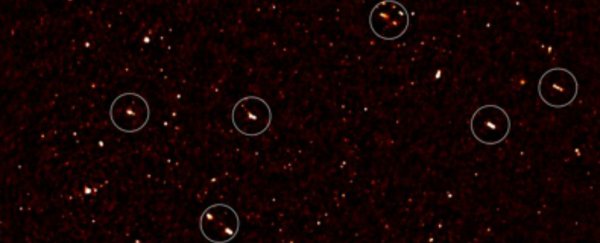There's a region in the distant Universe where a handful of supermassive black holes have mysteriously aligned, and as a result, they're spewing out incredibly powerful radio jets in the same direction. This is the first time astronomers have seen such a phenomenon, and they say it could be the result of fluctuations of primordial mass that appeared in the early Universe.
"Since these black holes don't know about each other, or have any way of exchanging information or influencing each other directly over such vast scales, this spin alignment must have occurred during the formation of the galaxies in the early Universe," explains one of the team, Andrew Russ Taylor, director of South Africa's Institute for Data Intensive Astronomy.
As with many discoveries that happen in outer space, no one was expecting to find a region where supermassive black holes had mysteriously managed to sync up their spins.
Taylor and his team were actually on the hunt for the faintest radio sources in the Universe, using data from the Giant Metrewave Radio Telescope (GMRT) in India - one of the largest and most sensitive radio telescope arrays in the world.
The GMRT had just completed a three-year deep radio imaging survey, detecting radio waves spewed forth by black holes in a distant region of the Universe called ELAIS, which encompasses several galaxies.
By looking at the direction these radio waves were coming from, the researchers figured out that within ELAIS-N1, the supermassive black holes at the centre of each of these galaxies were all spinning in the same direction. But how?
Taylor and his colleagues suggest that the black holes are too far apart to have influenced each other's alignment in their current positions in space, so whatever forced them into the same spin must happened very early on in the formation of the Universe.
"[T]he alignment of the black holes is probably caused by an overall spin in the structure of this region of space, triggered by fluctuations of primordial matter in the early Universe, way before galaxies even formed," Yasmin Tayag reports for Inverse.
But if we accept that, then something even greater must have given rise to the fluctuations of primordial matter that caused these supermassive black holes to align. In other words, what caused the fluctuations that forced these black holes into the same spin?
It's not yet clear, and a large-scale spin distribution has not been predicted by our current understanding of the physics that govern the Universe, but the researchers suggest that it could be anything from incredibly strong cosmic magnetic fields - possibly associated with exotic particles such as axions - to something called cosmic strings, which are theoretical fault lines in the Universe that exist between different regions of space.
"This is not obviously expected based on our current understanding of cosmology. It's a bizarre finding," astronomer Romeel Dave from the University of Western Cape in South Africa, who was not involved in the discovery, said in a press statement.
We're going to need much more sensitive telescopes to figure that out, and with the South African MeerKAT radio telescope and the Square Kilometre Array (SKA) - the world's most powerful radio telescope and one of the biggest scientific instruments ever devised - currently under construction, we might not have to wait too long.
"[We really need MeerKAT to make the very sensitive maps, over a very large area and with great detail, that will be necessary to differentiate between possible explanations," says Taylor. "It opens up a whole new research area for these instruments, which will probe as deeply into the and as far back as we can go - it's going to be an exciting time to be an astronomer."
The discovery has been reported in the Monthly Notices of the Royal Astronomical Society.
